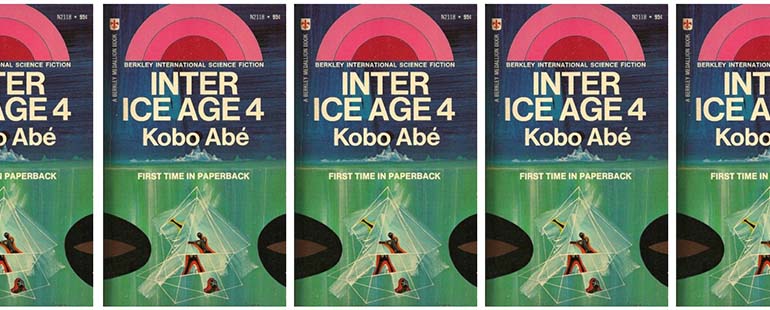Climate Resignation in Inter Ice Age 4

In Amitav Ghosh’s book-length essay The Great Derangement (2016), he argues that most climate change stories produce ineffective literary fiction because the process of climate change is too slow to credibly depict within narrative conventions. As a result, introducing a natural disaster in the middle of the story will read as contrived. “To introduce such happenings into a novel is in fact to court eviction from the mansion in which serious fiction has long been in residence,” he explains, adding that doing so “is to risk banishment to the humbler dwellings that surround the manor house—those generic outhouses that were once known by names such as ‘the Gothic,’ ‘the romance,’ or ‘the melodrama,’ and have now come to be called ‘fantasy,’ ‘horror,’ and ‘science fiction.’” In short, he argues, literary fiction is ill-equipped to dramatize the climate crisis. The most effective climate fiction involves genre elements.
I was thinking about this narrative problem while reading Kōbō Abe’s classic sci-fi thriller Inter Ice Age 4 (contrary to the title, it is not the fourth novel in a series of “Inter Ice Age” volumes). Originally published in 1958 and 1959 as a serialized story in Sekai Magazine, and published in English translation in 1970 by E. Dale Saunders, the book may be one of the most effective novels to consider a very human reaction to impending climate disaster—resignation. Notably, Abe requires genre elements to accomplish the necessary suspension of disbelief, adding further confirmation to Ghosh’s thesis.
Abe’s work is varied and complex. Best known for the existentialist novels The Woman in the Dunes (1962) and The Face of Another (1964), both adapted into acclaimed films by Hiroshi Teshigahara, Abe was also a practiced deconstructor of genre, often subverting genre elements to tackle more heady material. His 1967 novel, The Ruined Map, for example, follows a Philip Marlowe-esque detective in his search for a missing person, but despite the story mostly hewing to the familiar noir formula, the detective never solves the mystery, and by the book’s conclusion, he descends into a nervous breakdown, actualizing the hardboiled genre’s themes of urban alienation by overwhelming the protagonist’s psyche within the frame of the story.
In Inter Ice Age 4, Abe spins a tale that draws from both Dashiell Hammett-style minimalist mystery telling, à la The Thin Man, and provocative sci-fi premises not unlike Philip K. Dick’s contemporary work in science fiction. The novel follows a Japanese government scientist named Professor Katsumi who has the use of a forecasting computer that supposedly can predict the future. Trying to test the computer’s effectiveness, Katsumi and his assistant, Tanomogi, decide to try to predict the future of a particular human subject, selected at random. When that man is suddenly found dead, Katsumi finds himself in a race to uncover a conspiracy that has infected every corner of the Japanese government.
As I can’t explain any more of the book’s larger themes without spoiling the novel, allow me to spoil the novel. What Katsumi uncovers is that, due to the pending rising sea levels that will arrive as a result of the book’s titular geologic epoch, the government has given up on trying to save humanity as it exists. Instead, they have embarked on a troubling and far-ranging scheme to steal human fetuses from pregnant women and genetically modify them to become an aquatic species of humans with gills, dubbed by the novel’s characters as aquans. In the novel’s climate future, there will remain no more inhabitable land; therefore the aquans, living underwater in aquatic settlements, will become the successor to the human race. The insanity of this plan (its disturbing relevance to the modern political discussion regarding women’s reproductive rights notwithstanding) is irrelevant in the minds of the novel’s secretive government leaders—the forecasting computer has told them that this fate must be so.
Abe’s protagonist, notably, does not resist the scheme. His arc goes from one of rebellion—as he uncovers the plot and his government organization’s complicity with it—to that of acceptance. After watching the forecasting computer’s projection of the future—a young aquan crawling ashore and observing the ruins of land-based human civilization before expiring—Katsumi accepts that he cannot stop the steady march of the future and the radically changing climate, nor can he adequately resist his government’s plan to create the aquans. Katsumi is confronted with a fait accompli, and his final choice is to accept his lack of agency.
Now, it is apparent that most modern governments are most likely incapable of secretly cloning a successor to the human species—in the United States, it is almost impossible to pass a bill to repave highways—but Katsumi’s resigned reaction to the climate crisis and its flawed solution is relevant for the purpose of dramatizing the problem of climate change. After all, much has been written on how individual consumption bears little impact on the climate crisis—what is really needed are far-ranging policy changes that tackle the macro levels of consumption: restructuring the world economy to be less reliant on fossil fuels.
As atmospheric scientist and climate activist Michael E. Mann wrote in Time magazine in 2019, “There is a long history of industry-funded ‘deflection campaigns’ aimed to divert attention from big polluters and place the burden on individuals.” He added, “The bigger issue is that focusing on individual choices around air travel and beef consumption heightens the risk of losing sight of the gorilla in the room: civilization’s reliance on fossil fuels for energy and transport overall, which accounts for roughly two-thirds of global carbon emissions.”
By either intuition or accident, the situation that Katsumi faces in the novel is the same problem that individuals face every day when told about the climate future that, on their own, they cannot change; their governments must align to take collective action. But what if the collective action that the institutions end up taking is radical and already far along in the process? Katsumi’s very understandable reaction is that he gives in, just as many in real life have become resigned to a rapidly warming earth and ineffective political institutions.
If we are to look to Abe for his intent in writing Inter Ice Age 4, we are fortunate: in an enigmatic postscript, he explains the philosophical question he was trying to explore through the novel. He starts off by saying that many works of science fiction ascribe a positive or negative outcome for the future of human societies. Abe explains, however, that “the real future . . . manifests itself like a ‘thing,’ beyond the abyss that separates it from the present, beyond the value judgments of the present. For example, if a man from the fifteenth century could return to life today, would he consider the present hell or paradise? Whatever he thought, one thing is quite clear and that is that he would no longer have the competency to judge.” For Abe, the future is truly unknowable to a member of the present, and someone living in the past who might be magically brought to the present day would not be capable of assessing whether the future was “good” or “bad”—it would just be incomprehensible. When Katsumi watches the forecast of the future, the aquan youth dying ashore and his body being carried away by the currents, Katsumi is left speechless. “Could man be made to assume responsibility by just existing?” the protagonist finally asks himself. “Perhaps so. In a quarrel between parents and children, it is always the children who judge.”
Because the future is impossible to comprehend from the vantage of the present, only the intervention of a science-fiction device such as a forecasting machine can provoke the internal dialogue within a character such as Katsumi. In keeping with Ghosh’s thesis, a literary story about climate requires the use of genre elements.
Inter Ice Age 4 was prescient because it is the impossibility of totally envisioning the future that comprises one of the major problems of climate change, making it so hard for the entire public to accept the reality of what will follow from our carbon consumption. Morever, Katsumi’s individual agency is flattened and small compared to the macro decisions made by the authorities in his society. “I shall have fulfilled one of the purposes of this novel,” Abe wrote, “if I have been able to make the reader confront the cruelty of the future, produce within him anguish and strain, and bring about a dialogue with himself.”
By dramatizing the arc of a character who becomes resigned to a future outside his control—and asking the reader to step into that character’s shoes—Abe’s work actually offers an explanation for why our society has failed to adequately address the climate crisis. A forgotten classic in the realm of climate fiction, Inter Ice Age 4 represents a telling effort in assessing why so many of us feel resigned to our climate fate—and why it is fundamentally difficult to understand the magnitude of the problem that lies before us.
This piece was originally published on December 17, 2021.



